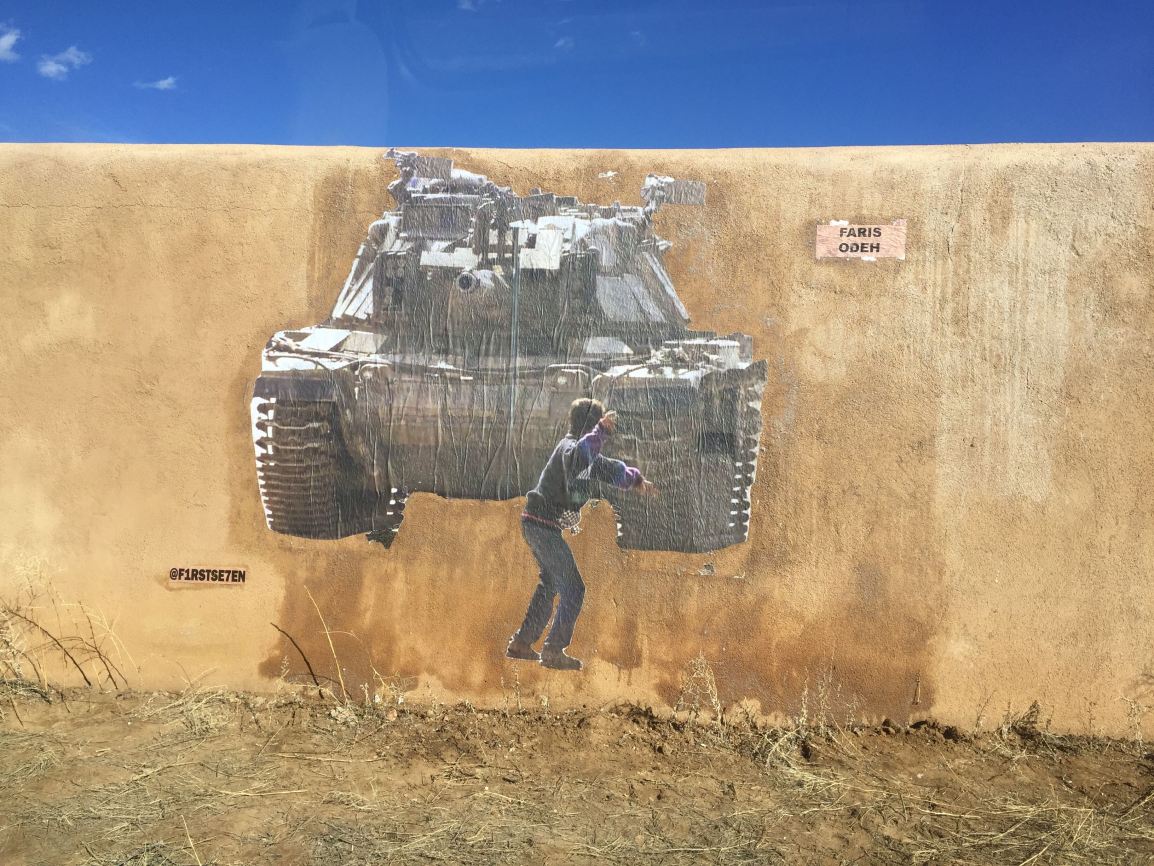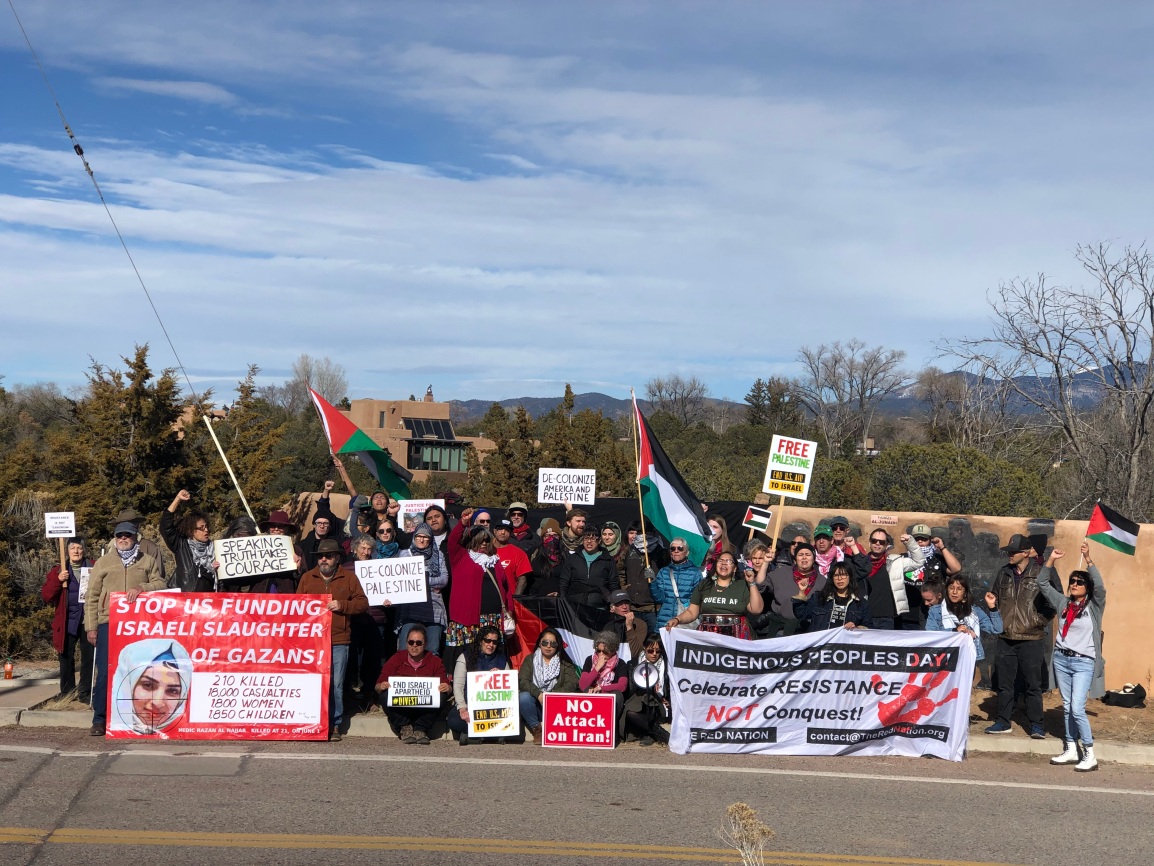"Our Resistance Is Global, and So Are We": The Red Nation-Santa Fe Stands with Palestine
by Elena Ortiz
The Red Nation-Santa Fe held a rally on Saturday, February 15 in solidarity with our Palestinian relatives who live under brutal occupation by the settler state of Israel. We were there to support Diné artist Remy and the images he put up in honor of the Palestinian people. The Red Nation came out in recognition of the struggles of the Wetʼsuwetʼen people; our relatives in the global south and all Indigenous people who are rising against settler-colonialism, imperialism and capitalism. We were there because our ancestors rose against these very systems in 1680. And, for a time, we rid our homelands of the settlers. We were there because with that legacy come responsibility. And we were there to answer that call.
The “controversy” surrounding the images Remy put on the wall is two-fold. The first issue is the city of Santa Fe and the Historic Design Review Board who, ostensibly, object to the medium of the images, which is wheat paste. There are no explicit references to wheat paste in the city codes, so it is not a forbidden substance. Likely, the objections stem from images themselves.

The Historic Design Review Board was created to gatekeep the city’s ‘heritage’ tourism industry. Native communities, art and culture are a huge part of that tourism industry. Yet, the installation by a Native artist on an adobe wall is outlawed. The colonial government imposes restrictions of what kind of Native art is allowed in the ‘historic district’, a designation only in existence since the mid-20th century. Pueblo people have lived in and around Ogah Po’geh for millennia.
The city of Santa Fe is more interested in the optics of the images and their effect on the
thousands of visitors who funnel millions of dollars into New Mexico’s tourist economy each year. Never mind that Native people and our art are one of the main draws for these visitors. Our existence must be “managed.”
The second issue is the content of Remy’s images, which show Palestinian women and children being brutalized by the Israeli Occupation Forces. Immediately after the images were put up the first time, local Zionists cried “anti-semitism” and “blood libel.” The first accusation is a tired trope which has been weaponized as a way to discredit legitimate criticism of Israel. The second accusation of “blood libel” is so ridiculous as to be rendered almost meaningless. The images of Faris Odeh and Razan al-Najjar come from actual photographs and their stories are taken from first-hand accounts.

On October 29, Laurent Rebours, a photographer from The Associated Press took the iconic picture of Faris Odeh that Remy used in his wheat paste installation. Faris was killed on November 9 at Karni. He was shot in the neck by Israeli troops and left to bleed to death on the battlefield. He was a few weeks shy of his 15th birthday.
Razan al-Najjar was an unarmed first responder in Gaza. She was working the front lines during the demonstrations for the Great March of Return. Razan was wearing a clearly identifiable white medic’s uniform and raising her hands in the air to show she was unarmed. Israeli soldiers fired from across the fence that imprisons Gaza, hitting her in the upper body. She was taken to a field hospital where she was later pronounced dead. She was 21 years old.
Blood libel is an inflammatory accusation which has no bearing in this context. We don’t care whether the soldiers who fired these kill shots were Jews or Gentiles. We don’t care if they were religious or secular. We don’t care if they were American-born or sabra. This is not an issue of religion or Arab vs. Jew. This is an issue of colonization and occupation of stolen land by the state of Israel. And it’s playing out on occupied stolen land in Santa Fe, NM.
Santa Fe is a border town whose entire tourist existence depends on Native people and the commodification of our culture. The architecture and style so obsessively defended by the Historic Design Review Board comes from Pueblo people. Had our ancestors not risen in bloody revolt against the first colonizers, the Spanish, little of it would be left to defend. Yet, our people are judged only by what we can create. We are not allowed to be political unless it serves the settler nation. We are not allowed to support global Indigenous liberation because it makes the settlers uncomfortable. Our voices, time and time again, are silenced by settler-colonial governments here and around the world.

The Red Nation is here to end that silence. You have no authority on stolen land. We are not your subjects. Our culture is not yours to consume. We are not only warriors in the battle for Indigenous liberation: we are the land defenders, the water protectors and the guardians of all non-human life on Mother Earth.
“To the racists tried to destroy the images of Indigenous struggle while living on stolen Tewa Land: This was never about a single wall in your bourgeoisie, upper class, institutional art city,” the Navajo artist Remy said. “Our resistance is global, therefore, so are we.”
